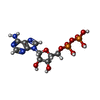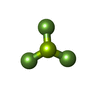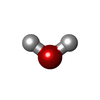[English] 日本語
 Yorodumi
Yorodumi- EMDB-52962: Cryo-EM structure of human Mre11-Rad50 (MR) complex bound to DNA ... -
+ Open data
Open data
- Basic information
Basic information
| Entry |  | |||||||||
|---|---|---|---|---|---|---|---|---|---|---|
| Title | Cryo-EM structure of human Mre11-Rad50 (MR) complex bound to DNA and telomeric factor TRF2 fragment (438-542) | |||||||||
 Map data Map data | ||||||||||
 Sample Sample |
| |||||||||
 Keywords Keywords | Mre11-Rad50-TRF2 complex / double-strand DNA break repair protein / nuclease / HYDROLASE | |||||||||
| Function / homology |  Function and homology information Function and homology informationchromosomal region / axonal transport of messenger ribonucleoprotein complex / negative regulation of telomere single strand break repair / telomeric 3' overhang formation / negative regulation of telomere maintenance via recombination / telomeric loop formation / mitochondrial double-strand break repair via homologous recombination / Mre11 complex / negative regulation of telomere maintenance via semi-conservative replication / negative regulation of telomeric D-loop disassembly ...chromosomal region / axonal transport of messenger ribonucleoprotein complex / negative regulation of telomere single strand break repair / telomeric 3' overhang formation / negative regulation of telomere maintenance via recombination / telomeric loop formation / mitochondrial double-strand break repair via homologous recombination / Mre11 complex / negative regulation of telomere maintenance via semi-conservative replication / negative regulation of telomeric D-loop disassembly / negative regulation of double-strand break repair via nonhomologous end joining / negative regulation of telomere capping / BRCA1-C complex / Sensing of DNA Double Strand Breaks / meiotic DNA double-strand break formation / protection from non-homologous end joining at telomere / regulation of mitotic recombination / RNA-templated DNA biosynthetic process / R-loop processing / Hydrolases; Acting on acid anhydrides / negative regulation of telomere maintenance / negative regulation of t-circle formation / telomeric D-loop disassembly / single-stranded DNA endodeoxyribonuclease activity / shelterin complex / chromosome organization involved in meiotic cell cycle / Telomere C-strand synthesis initiation / homologous chromosome pairing at meiosis / regulation of telomere maintenance via telomerase / double-stranded telomeric DNA binding / DNA strand resection involved in replication fork processing / homologous recombination / nuclease activity / G-quadruplex DNA binding / 3'-5'-DNA exonuclease activity / DNA double-strand break processing / Telomere C-strand (Lagging Strand) Synthesis / nuclear telomere cap complex / Impaired BRCA2 binding to PALB2 / single-stranded telomeric DNA binding / G-rich strand telomeric DNA binding / telomere capping / telomere maintenance via recombination / Cytosolic sensors of pathogen-associated DNA / mitotic G2/M transition checkpoint / HDR through MMEJ (alt-NHEJ) / Processive synthesis on the C-strand of the telomere / Polymerase switching on the C-strand of the telomere / IRF3-mediated induction of type I IFN / Removal of the Flap Intermediate from the C-strand / reciprocal meiotic recombination / mitotic intra-S DNA damage checkpoint signaling / regulation of telomere maintenance / negative regulation of telomere maintenance via telomere lengthening / protein localization to chromosome, telomeric region / Homologous DNA Pairing and Strand Exchange / Defective homologous recombination repair (HRR) due to BRCA1 loss of function / Defective HDR through Homologous Recombination Repair (HRR) due to PALB2 loss of BRCA1 binding function / Defective HDR through Homologous Recombination Repair (HRR) due to PALB2 loss of BRCA2/RAD51/RAD51C binding function / Resolution of D-loop Structures through Synthesis-Dependent Strand Annealing (SDSA) / sister chromatid cohesion / Resolution of D-loop Structures through Holliday Junction Intermediates / HDR through Single Strand Annealing (SSA) / telomeric DNA binding / positive regulation of double-strand break repair / Impaired BRCA2 binding to RAD51 / negative regulation of telomere maintenance via telomerase / mitotic G2 DNA damage checkpoint signaling / positive regulation of telomere maintenance / Presynaptic phase of homologous DNA pairing and strand exchange / negative regulation of cellular senescence / Telomere Extension By Telomerase / telomere maintenance via telomerase / Packaging Of Telomere Ends / Recognition and association of DNA glycosylase with site containing an affected purine / Cleavage of the damaged purine / 3'-5' exonuclease activity / Recognition and association of DNA glycosylase with site containing an affected pyrimidine / Cleavage of the damaged pyrimidine / telomere maintenance / Inhibition of DNA recombination at telomere / Meiotic synapsis / protein serine/threonine kinase activator activity / replication fork / condensed nuclear chromosome / DNA endonuclease activity / male germ cell nucleus / Nonhomologous End-Joining (NHEJ) / double-strand break repair via homologous recombination / PML body / G2/M DNA damage checkpoint / HDR through Homologous Recombination (HRR) / double-strand break repair via nonhomologous end joining / DNA Damage/Telomere Stress Induced Senescence / Meiotic recombination / cellular senescence / double-strand break repair / manganese ion binding / Recruitment and ATM-mediated phosphorylation of repair and signaling proteins at DNA double strand breaks / site of double-strand break Similarity search - Function | |||||||||
| Biological species |  Homo sapiens (human) Homo sapiens (human) | |||||||||
| Method | single particle reconstruction / cryo EM / Resolution: 2.59 Å | |||||||||
 Authors Authors | Cui HJ / Lammens K / Hopfner KP / Fan YL / Kuybu F | |||||||||
| Funding support |  Germany, 1 items Germany, 1 items
| |||||||||
 Citation Citation |  Journal: Nat Commun / Year: 2025 Journal: Nat Commun / Year: 2025Title: Structural basis for DNA break sensing by human MRE11-RAD50-NBS1 and its regulation by telomeric factor TRF2. Authors: Yilan Fan / Filiz Kuybu / Hengjun Cui / Katja Lammens / Jia-Xuan Chen / Michael Kugler / Christophe Jung / Karl-Peter Hopfner /  Abstract: The MRE11-RAD50-NBS1 (MRN) complex is a central, multifunctional factor in the detection, signaling and nucleolytic processing of DNA double-strand breaks (DSBs). To clarify how human MRN binds ...The MRE11-RAD50-NBS1 (MRN) complex is a central, multifunctional factor in the detection, signaling and nucleolytic processing of DNA double-strand breaks (DSBs). To clarify how human MRN binds generic and telomeric DNA ends and can separate DNA end sensing from nuclease activities, we determined cryo-electron microscopy (cryo-EM) structures of human MRN bound to DNA and to DNA and the telomere protection factor TRF2. MRN senses DSBs through a tight clamp-like sensing state with closed coiled-coil domains, but auto-inhibited MRE11 nuclease. NBS1 wraps around the MRE11 dimer, with NBS1's ATM recruitment motif sequestered by binding to the regulatory RAD50 S site, necessitating a switch in the NBS1 C helix for ATM activation. At telomeric DNA, TRF2 blocks the second S site via the iDDR motif to prevent nuclease and ATM activation. Our results provide a structural framework for DNA sensing via a gating mechanism and separation of sensing, signaling and processing activities of mammalian MRN. | |||||||||
| History |
|
- Structure visualization
Structure visualization
| Supplemental images |
|---|
- Downloads & links
Downloads & links
-EMDB archive
| Map data |  emd_52962.map.gz emd_52962.map.gz | 168 MB |  EMDB map data format EMDB map data format | |
|---|---|---|---|---|
| Header (meta data) |  emd-52962-v30.xml emd-52962-v30.xml emd-52962.xml emd-52962.xml | 25.8 KB 25.8 KB | Display Display |  EMDB header EMDB header |
| FSC (resolution estimation) |  emd_52962_fsc.xml emd_52962_fsc.xml | 11.9 KB | Display |  FSC data file FSC data file |
| Images |  emd_52962.png emd_52962.png | 156.4 KB | ||
| Masks |  emd_52962_msk_1.map emd_52962_msk_1.map | 178 MB |  Mask map Mask map | |
| Filedesc metadata |  emd-52962.cif.gz emd-52962.cif.gz | 8.5 KB | ||
| Others |  emd_52962_half_map_1.map.gz emd_52962_half_map_1.map.gz emd_52962_half_map_2.map.gz emd_52962_half_map_2.map.gz | 165.5 MB 165.4 MB | ||
| Archive directory |  http://ftp.pdbj.org/pub/emdb/structures/EMD-52962 http://ftp.pdbj.org/pub/emdb/structures/EMD-52962 ftp://ftp.pdbj.org/pub/emdb/structures/EMD-52962 ftp://ftp.pdbj.org/pub/emdb/structures/EMD-52962 | HTTPS FTP |
-Validation report
| Summary document |  emd_52962_validation.pdf.gz emd_52962_validation.pdf.gz | 895.9 KB | Display |  EMDB validaton report EMDB validaton report |
|---|---|---|---|---|
| Full document |  emd_52962_full_validation.pdf.gz emd_52962_full_validation.pdf.gz | 895.5 KB | Display | |
| Data in XML |  emd_52962_validation.xml.gz emd_52962_validation.xml.gz | 20.8 KB | Display | |
| Data in CIF |  emd_52962_validation.cif.gz emd_52962_validation.cif.gz | 27 KB | Display | |
| Arichive directory |  https://ftp.pdbj.org/pub/emdb/validation_reports/EMD-52962 https://ftp.pdbj.org/pub/emdb/validation_reports/EMD-52962 ftp://ftp.pdbj.org/pub/emdb/validation_reports/EMD-52962 ftp://ftp.pdbj.org/pub/emdb/validation_reports/EMD-52962 | HTTPS FTP |
-Related structure data
| Related structure data |  9q9kMC  9q9hC  9q9iC  9q9jC  9q9mC M: atomic model generated by this map C: citing same article ( |
|---|---|
| Similar structure data | Similarity search - Function & homology  F&H Search F&H Search |
- Links
Links
| EMDB pages |  EMDB (EBI/PDBe) / EMDB (EBI/PDBe) /  EMDataResource EMDataResource |
|---|---|
| Related items in Molecule of the Month |
- Map
Map
| File |  Download / File: emd_52962.map.gz / Format: CCP4 / Size: 178 MB / Type: IMAGE STORED AS FLOATING POINT NUMBER (4 BYTES) Download / File: emd_52962.map.gz / Format: CCP4 / Size: 178 MB / Type: IMAGE STORED AS FLOATING POINT NUMBER (4 BYTES) | ||||||||||||||||||||||||||||||||||||
|---|---|---|---|---|---|---|---|---|---|---|---|---|---|---|---|---|---|---|---|---|---|---|---|---|---|---|---|---|---|---|---|---|---|---|---|---|---|
| Projections & slices | Image control
Images are generated by Spider. | ||||||||||||||||||||||||||||||||||||
| Voxel size | X=Y=Z: 0.727 Å | ||||||||||||||||||||||||||||||||||||
| Density |
| ||||||||||||||||||||||||||||||||||||
| Symmetry | Space group: 1 | ||||||||||||||||||||||||||||||||||||
| Details | EMDB XML:
|
-Supplemental data
-Mask #1
| File |  emd_52962_msk_1.map emd_52962_msk_1.map | ||||||||||||
|---|---|---|---|---|---|---|---|---|---|---|---|---|---|
| Projections & Slices |
| ||||||||||||
| Density Histograms |
-Half map: #2
| File | emd_52962_half_map_1.map | ||||||||||||
|---|---|---|---|---|---|---|---|---|---|---|---|---|---|
| Projections & Slices |
| ||||||||||||
| Density Histograms |
-Half map: #1
| File | emd_52962_half_map_2.map | ||||||||||||
|---|---|---|---|---|---|---|---|---|---|---|---|---|---|
| Projections & Slices |
| ||||||||||||
| Density Histograms |
- Sample components
Sample components
+Entire : MR-TRF2(438-542)-DNA complex
+Supramolecule #1: MR-TRF2(438-542)-DNA complex
+Macromolecule #1: Telomeric repeat-binding factor 2
+Macromolecule #4: DNA repair protein RAD50
+Macromolecule #5: Double-strand break repair protein MRE11
+Macromolecule #2: DNA (64-MER)
+Macromolecule #3: DNA (64-MER)
+Macromolecule #6: ADENOSINE-5'-DIPHOSPHATE
+Macromolecule #7: MAGNESIUM ION
+Macromolecule #8: BERYLLIUM TRIFLUORIDE ION
+Macromolecule #9: MANGANESE (II) ION
+Macromolecule #10: water
-Experimental details
-Structure determination
| Method | cryo EM |
|---|---|
 Processing Processing | single particle reconstruction |
| Aggregation state | particle |
- Sample preparation
Sample preparation
| Buffer | pH: 7.5 Details: 25mM Hepes-NaOH, pH 7.5, 150 mM NaCl, 1 mM DTT, 1 mM ATP, 1mM BeF3, 5 mM MgCl2, 1 mM MnCl2 |
|---|---|
| Grid | Model: Quantifoil R2/1 / Material: COPPER / Mesh: 200 / Support film - Material: CARBON / Support film - topology: HOLEY / Pretreatment - Type: GLOW DISCHARGE / Pretreatment - Time: 7 sec. / Details: 20 mA, 7 s |
| Vitrification | Cryogen name: ETHANE / Chamber humidity: 95 % / Chamber temperature: 283 K / Instrument: LEICA PLUNGER |
- Electron microscopy
Electron microscopy
| Microscope | TFS KRIOS |
|---|---|
| Specialist optics | Energy filter - Name: GIF Bioquantum / Energy filter - Slit width: 20 eV |
| Image recording | Film or detector model: FEI FALCON IV (4k x 4k) / Detector mode: COUNTING / Average electron dose: 40.0 e/Å2 |
| Electron beam | Acceleration voltage: 300 kV / Electron source:  FIELD EMISSION GUN FIELD EMISSION GUN |
| Electron optics | Illumination mode: FLOOD BEAM / Imaging mode: BRIGHT FIELD / Cs: 2.7 mm / Nominal defocus max: 2.6 µm / Nominal defocus min: 0.5 µm |
| Sample stage | Cooling holder cryogen: NITROGEN |
| Experimental equipment |  Model: Titan Krios / Image courtesy: FEI Company |
+ Image processing
Image processing
-Atomic model buiding 1
| Initial model | Chain - Source name: AlphaFold / Chain - Initial model type: in silico model |
|---|---|
| Refinement | Space: REAL / Protocol: RIGID BODY FIT |
| Output model |  PDB-9q9k: |
 Movie
Movie Controller
Controller












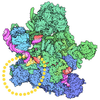

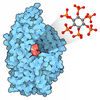
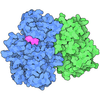

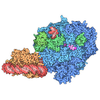
 Z (Sec.)
Z (Sec.) Y (Row.)
Y (Row.) X (Col.)
X (Col.)












































 Trichoplusia ni (cabbage looper)
Trichoplusia ni (cabbage looper)